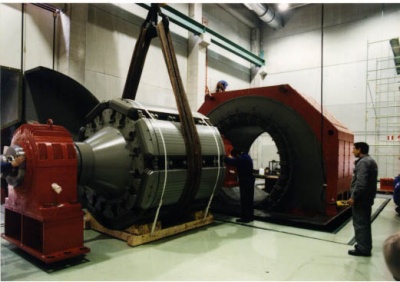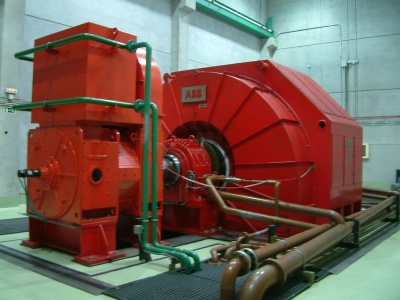TJ-II:Power supply: Difference between revisions
No edit summary |
No edit summary |
||
| (One intermediate revision by the same user not shown) | |||
| Line 12: | Line 12: | ||
[[File:TJ-II_flywheel.JPG|400px|thumb|right|The TJ-II flywheel generator]] | [[File:TJ-II_flywheel.JPG|400px|thumb|right|The TJ-II flywheel generator]] | ||
The configurational flexibility of the TJ-II has been broadened by the commissioning of a new mode of operation that allows magnetic configurations to be varied dynamically during the discharge flat-top. In order to achieve this, new hardware and software features have been added to the TJ-II Control System. | The configurational flexibility of the TJ-II has been broadened by the commissioning of a new mode of operation (the 'C-mode') that allows magnetic configurations to be varied dynamically during the discharge flat-top. In order to achieve this, new hardware and software features have been added to the TJ-II Control System. | ||
<ref>A. de la Peña, ''A real-time current driving control system for the TJ-II coils'', [[doi:10.1016/j.fusengdes.2008.12.010|Fusion Engineering and Design '''84''', Issues 2-6 (2009) 676-680]]</ref> | <ref>A. de la Peña, ''A real-time current driving control system for the TJ-II coils'', [[doi:10.1016/j.fusengdes.2008.12.010|Fusion Engineering and Design '''84''', Issues 2-6 (2009) 676-680]]</ref> | ||
== See also == | |||
* [[TJ-II:Coil system]] | |||
== References == | == References == | ||
<references /> | <references /> | ||
Latest revision as of 13:41, 17 July 2024

The generation of the magnetic field during a TJ-II discharge requires a total amount of power of almost 50 MW. This power is supplied by the national grid and a 140 MW flywheel generator (100 MJ, 15 kV, 100 Hz). As the TJ-II loads require a direct current, a set of thyristor converters, transformers and circuit breakers are used for each coil system. The power requirements range from 5 kA (100 V) to 32 kA (1000 V). The heating systems (ECRH and NBI) load the power supply with additional 15 MW. [1] [2] [3] [4]

The configurational flexibility of the TJ-II has been broadened by the commissioning of a new mode of operation (the 'C-mode') that allows magnetic configurations to be varied dynamically during the discharge flat-top. In order to achieve this, new hardware and software features have been added to the TJ-II Control System. [5]
See also
References
- ↑ A. Pérez et al, Power supply for the Spanish Stellarator TJ-II, design, construction and tests, Fusion Engineering, Proc. SOFE 1995. Seeking a New Energy Era, 16th IEEE/NPSS Symposium, 2 (1995) 1066-1069
- ↑ A. Pérez et al, Current ripple in the coils of the TJ-II Spanish stellarator, Fusion Engineering, Proc. SOFE 1995. Seeking a New Energy Era, 16th IEEE/NPSS Symposium, 2 (1995) 1070-1073
- ↑ P. Méndez, High power IGBT bridge application for the harmonic suppression on the load side of the power supply system of the Spanish Stellarator TJ-II, Fusion Engineering and Design 75-79 (2005) 123-126
- ↑ J. Izquierdo et al, Reliability of the TJ-II power supply system: Collection and analysis of the operational experience data, Fusion Engineering and Design 82, Issues 15-24 (2007) 2765-2771
- ↑ A. de la Peña, A real-time current driving control system for the TJ-II coils, Fusion Engineering and Design 84, Issues 2-6 (2009) 676-680